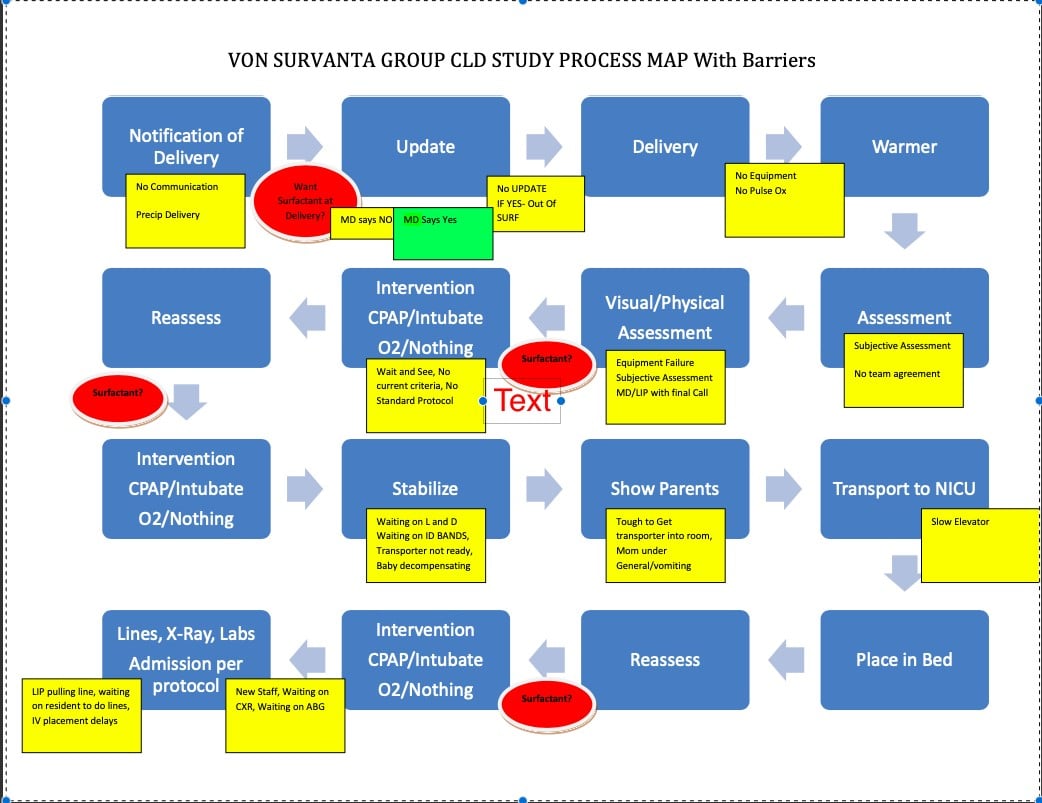Process Mapping & Flow Charts
Alan P. Picarillo, MD
Maine Neonatology Associates & the Maine Medical Center Department of Pediatrics.
Learning objectives
- Understand the difference between simple and complex process maps.
- Describe the steps to construct a process map.
Process mapping, also known as a flow chart, is a pictorial demonstration of the sequential steps involved in a process1,2. It may be a simple or complex tool, as each and every step of a procedure needed to deliver care (e.g. which steps are involved when an infant receives surfactant therapy) is documented. Simple maps, also known as high level process maps, show how the process works in just a few steps. The purpose is to provide quick and easy insights into what the process does, without getting into the details of how it’s done. This simple map can be useful when communicating a process to leadership, but it does not encompass the details of each process step. Complex process maps include significantly more detail than simple maps and may be required if the team is planning on streamlining an entire comprehensive process. Creation of a complex map requires more team members and front-line participants in order to record the required details of each discrete step.
In order to be useful, process maps should not be created by a single individual, but rather by input of a multidisciplinary team. The various members of the healthcare team provide an understanding of how each step may be influenced by the preceding or subsequent steps in a process. By using process maps, the team is able to visualize how each member performs a step in a certain procedure, allowing for an improved understanding of each other’s roles and responsibilities during clinical situations. The value of the map created in a multidisciplinary meeting allows for discussion, and more importantly, understanding and appreciation of each other’s roles in discrete steps of the process. This establishes a baseline knowledge of the process for all team members and once completed, the team proceeds with identification of steps that are wasteful and do not add value to the overall process. The identification of important steps that add value to a process and the elimination of steps that do not add value are tenets of Lean management. Lean management is a systematic method for removing waste from processes without impacting productivity an although Lean management has roots in manufacturing, it has been rapidly adopted by healthcare systems3
Creation of a process map does not need to be elegant or sophisticated; most successful process maps are created by pieces of paper representing each step that are then attached to the walls of a meeting room (Figure 1). The use of this tool allows participants to discover that some of the steps in the procedure may involve delays in care, unnecessary/repetitive work or communication errors; all steps that add little value and may be able to be modified or even eliminated. Further refinement of the process by the team can serve as a basis for designing a new and improved process.
- Dias S, Saraiva PM. (2004). Use Basic Quality Tools To Manage Your Processes. Quality Progress, 37(8), 47-53
- TrebbleTM, Hansi N, Hydes T,Smith MA, Baker M. Process mapping the patient journey: an introduction BMJ 2010; 341:c4078
- Joosten T, Bongers I, Janssen R Application of lean thinking to health care: issues and observations. Int J Qual Health Care2009;21:341–7.
Figure 1

This is a process map detailing sixteen discrete steps for surfactant administration to premature newborns. The yellow boxes detail steps where the team had identified barriers or waste and the red circles identify opportunities to administer surfactant to the newborn
Download PDF